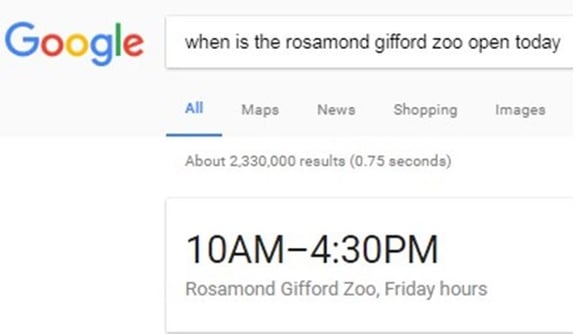Ok, Google, show me black-and-white pictures of the Eiffel Tower.
Ok, Google, how much should I tip on a $76 bill?
Ok, Google, where’s the closest diner?
Whether your preferred digital personal assistant is Google Home, Siri, Cortana, Amazon Alexa or another emerging digital assistant app, you’re probably at least somewhat familiar with voice search. It’s creating a lot of buzz in the content marketing world, and for good reason:
- It’s predicted that 50% of all searches will be voice searches by 2020 (Search Engine Watch)
- Google machine learning now has a 95% voice recognition accuracy rate (Internet Trends Report 2017 via KPCB)
It’s easy to see why voice search is on the upswing: it’s fast, it’s hands-free and it’s direct.
Fast: Humans can speak faster than they can type. Plus, consider how difficult it can be typing on smaller smartphone or tablet screens and the frustration of auto-correct errors.
Hands-free: Today’s technology allows people to multitask seamlessly – and safely. With voice search, someone can be driving and still dictate a text message to a loved one, or have their hands submerged in soapy water while doing the dishes and use voice search to pull up their favorite cleaning playlist.
Direct: No more complex navigation menus. No more sifting through search results. When you ask your digital personal assistant a question, the direct answer is read out loud to you. It’s that easy.
Voice search isn’t just about sending texts, placing calls and perusing entertainment options, either – it’s being used as a tool to find information by consumers, too, which is why content marketers should perk up and pay attention to voice search’s rising popularity.
According to a Stone Temple survey, when asked “what do you use voice commands for?”, online search came in second, after making a call, with over 60% of respondents citing organic search as their preferred voice command application.
With an increasing number of consumers using voice queries to conduct research and make purchasing decisions, it’s important to ask yourself, “is my content writing voice-search-friendly?” Keep reading to discover three easy ways you can optimize your business blog in the era of voice search.
1. Incorporate more long-tail keywords and conversational language into your content.
The shift from text search to voice search presents multiple implications for content strategists who are trying to figure out how to address their target audience’s problems and needs. Consider the following example:
If someone wanted to find out who a certain actress is in the Game of Thrones series, they may perform the following queries:
Text search: Mother of Dragons actress
Voice search: Who plays Daenerys Targaryen in Game of Thrones?
The most striking difference is the word length. The text search is only four words, while the voice search is double the length at eight words. As you can see, text queries aren’t usually complete sentences, while voice queries are. While text searches are condensed down to the most essential words, voice searches include filler words, like “the”, “for”, “to” and “of.”
Furthermore, look at the difference in language used. “Mother of Dragons” versus the character’s actual name, “Daenerys Targaryen.” The latter is difficult to spell, so it wouldn’t normally be typed, but the Game of Thrones’ audience is used to hearing how it sounds when watching the show, so they would be much more likely to speak it.
Let’s see what kinds of results both of these queries generate on Google. Not surprisingly, the coveted number one position is won by Wikipedia, followed by IMDb and The Sun. But after that, the remaining SERP for both queries differs completely, despite the answer (Emilia Clarke) being the same for both.
So what can marketers learn from this example? If text and voice queries yield different search results, that means your content writing could rank for text searches, but not voice searches, regarding the same core question. The result? You lose out on a significant portion of consumers who have a question that you have an answer to.
By emphasizing long-tail keywords and using natural, conversational language in your content, Siri is much more likely to find you.
2. Target Google’s featured snippets by focusing on answers to consumer questions.
A featured snippet on Google is a brief answer to a searched question that Google reads out loud and displays above the regular SERP. This snippet is taken from a web page, which is usually the first search result.
Here’s an example of a featured snippet for a voice query regarding the local zoo’s hours of operation:

In order to achieve the coveted “position zero” on Google, start clustering your content around specific answers. Add an FAQ page to your website, where you address common customer queries regarding your products, services or industry. When formulating your answers, use natural language that reflects how your customers actually speak. And as you start to build content around voice search, always consider how your featured snippet will sound being read aloud by Google or Siri.
3. Insert location-based information into your content.
With geo-location services built into most smartphones, people can find restaurants, shopping centers, hospitals and any other nearby establishment they’re seeking within seconds. Have you performed any of the following location-based voice queries?
Find authentic Thai restaurants near me.
Where can I get my oil changed today?
Where’s the closest drive-in movie theater?
Chances are, even if you haven’t performed the exact voice queries listed above, you’ve probably conducted some type of location-based voice search before. In fact, according to the Internet Trends Report 2016, local information and content make up 22% of all voice queries.
So what can you do to optimize your content for local SEO? Be sure to reference location markers in your copy frequently, as long as it’s natural and doesn’t feel forced. Here are some ideas:
- Call out specific neighborhoods and nearby landmarks that locals would be familiar with.
- Mention larger, more well-known cities that are close to your business. If you’re 50 miles south of Atlanta, be sure to say that.
- Don’t hesitate to use local terminology for surrounding areas or specific places. Just because these names won’t necessarily be printed on a map, doesn’t mean locals won’t be referencing them in their voice searches.
- If you haven’t already, make sure to set up a Google My Business listing and keep it up to date with a relevant business address, phone number and hours of operation.
When you’re consistently working local SEO into your digital content, location-based voice searches are much more likely to lead to your business.
According to experts, voice search is only going to continue rising in popularity and usage in the coming years. If you’re concerned about creating voice-search-rankable content, outsource content creation for your business to a professional content agency. Download our free ebook to learn six questions you should ask when choosing a content partner.
And be sure to leave us a comment regarding your thoughts on the future of voice search and its impression on the content marketing world.
About Virtucom Group
Consistent business blogging yields results – more clicks, more subscribers and – ultimately – more conversions. Whether you’re writing an automotive blog, an accounting blog, a healthcare blog or a home renovation blog, blogging for business and content development are useful for any industry. Follow the content writers at the Virtucom Group blog as they share digital marketing tips and discuss website content writing services that can optimize your business blog.






